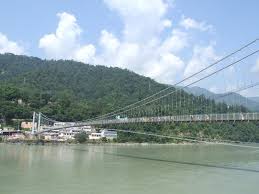

Bhagavad Gita has 700 slokas. If we want to see all the slokas inscribed at one place, then we should visit Gita Bhavan. Already we have seen Lakshman Jhula on the banks of Ganga. That was the place where Lakshmana did his penance. Now, we have arrived at Sri Ram Mandir and Sri Rama - Gita parayana sthambam. Here, there is facility for bathing in Ganga. It is called Ram Ghat. Many people bathe and chant the Divine name of Sri Rama. Here, we can also see Ram jhula.

Travelling by that and then if we climb stairs, we are welcomed by Gita Bhavan. We might have heard of the famous Gita Press of Ghorakpur. They print and publish Thousands of religious books. Even today, if Millions of people are able to read Gita, the credit goes to Gita Press. We can see all those books printed and stored, in Gita Bhavan here. After crossing it we came to a beautiful garden and we also see Sri Lakshmi Narayan sannidhi. We can see the gopuram constructed as per Northern architecture. Around this, Sri Krishna's pranks and other plays are painted. More than all these, are the 700 slokas written here. All the 18 Chapters are written in white letters on red stones. Apart from this, every year, for about Four months, from Chittirai to Aadi, many noble persons stay here and conduct Akhanda Parayanam, non-stop recitation, of Gita. We will now study Gita here and it is a pleasant combination! Sri Krishna continues with His reply in sloka 3 of Chapter 18. In sloka 2, we saw Two different opinions about Tyaga. The Lord mentioned that one group felt discarding Kamya karma alone, altogether, was the right thing. But another group felt that it was not necessary to forgo kamya karma, but it should also be done, renouncing only the results of them. We may get a doubt here as to whether Nitya and naimittika karma produce any result. Shastras say 'prajapatyam grahastanam' - Gruhastas [married persons] would get superior positions by performing Nitya karmas. Even though we might not aspire for any result, but in indirect way, they would fetch results. Even this has to be renounced, according to the Second school of thought. A Third opinion and the Lord's stand on these are described in sloka 3:
tyājyaṃ doṣavad ity eke karma prāhur manīṣiṇaḥ
yajñadānatapaḥkarma na tyājyam iti cāpare 18.3
Tyajyam = to be renounced, karma = any type of karma, because, dosavad = [any karma has] defects or blemishes. This group drops a bomb-shell! They say all karmas [nitya, naimittika and kamya] have to be totally renounced! Because every karma has blemish in it. This is the opinion of Sankhya philosophy, preached by Sri Kapila, an avatar of the Lord. Like anger, lust, etc., are harmful, so one should not practice any Vedic karma and cause sufferings. Thus this group advocates giving up sandyavandanam, annual ceremonies for the deceased, yagna, etc. What is the blemish in them? In many Yagnas, certain animals are sacrificed; similarly, other karmas also cause sufferings for the performer and others. For example, observing Ekadasi means fasting and this is inflicting suffering on the self. In performing annual ceremonies for the deceased, the performer has to be in fasting till all have taken food. This is also a sort of suffering. Thus every karma has the defect of causing suffering for someone. Therefore, this group advises renouncement of all karmas. Eke manisina = [advocated by] one type of persons, prahu = say. Since karmas here mentioned are general, does it mean one has to give up all karmas or actions, including eating, bathing, etc.? But this has come in the context of Vedic karmas and so renouncement is for Vedic karmas alone. Also, those desirous of Moksham alone have to renounce such Vedic karmas. Because, karma with blemishes will yield results that have blemishes like happiness in this world or in Swarga. To get blemishless Moksham, according to this group, karmas with blemishes have to be renounced. After telling all these Three opinions about Tyaga, viz.:
- Kamya karmas alone have to be renounced, while nitya and naimittika karmas have to be continued.
- Perform all karmas -nitya, naimittika and kamya - but renounce only the results.
- Since all Vedic karmas have dosha or blemish, renounce all Karmas, including nitya and naimittika,
No comments:
Post a Comment